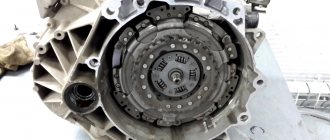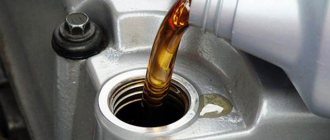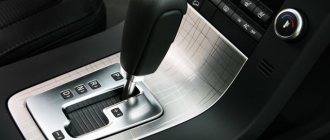- home
- car transmission
- …
Modern automatic transmissions are not at all similar to their predecessors that were 20 - 30 years ago. At the dawn of their appearance, they were completely controlled by hydromechanical drives and there simply were no electronics! Their reliability was off the charts, they easily lasted 200 - 300,000 kilometers, the main thing was to have proper maintenance, change the oil and filter. BUT modern automatic transmissions are far from this; they have quite a lot of electronics that control the box. Today's automatic machines, almost all of them are adaptive, they adapt to the driver's driving style and to certain conditions (“city-traffic jams”, “highway-overtaking”, etc.). But sometimes they are wildly “stupid”, although they can be cured of this by simple “training”. In general, today everything is in order, it will be interesting...
Now a little definition
Adaptive automatic transmission (automatic) - has a special electronic unit in its structure that “gets used” (adapts) to the driving style and helps to choose the optimal relationship between engine speed and gear shifting.
It seems to me that now there are no ordinary automatic transmissions anymore, unless in some museums. Now all modern automatic machines are a mixture of hydraulics, oil and electronics. Actually, the process itself has changed little; there is also a shaft that transmits torque to the torque converter, and after that the clutches engage the necessary gears of the planetary mechanism, connecting the necessary gears. However, on new automatic machines this entire process is controlled by electronics; it decides at what speed the solenoids open and shift gears.
Why adaptation is needed
The answer is simple: this function provides the most comfortable driving conditions throughout the entire range of speed characteristics. This becomes possible thanks to the use of the electronic component, it controls:
- Acceleration dynamics (calm or accelerated acceleration)
- Driving modes. With the gas pedal position unchanged, a higher gear saves fuel
- Acceleration modes. During sudden acceleration, the sports program is activated
- Braking modes. During sharp braking modes (sports braking), the automatic transmission shifts “down” to several gears at once.
Thus, the operation of the box becomes clearer and more thoughtful. It's not always simple though.
What are adaptive gearboxes?
The design of the car is very rational; over the many years of its existence, not a single unit has remained that has not undergone some changes in order to make it work more efficiently, as well as to provide the most comfortable conditions for the driver when driving. One of the results of such modernization of components is an adaptive gearbox, which is the result, hopefully not the final one, of the long history of the development of this element of the car design.
How long does it take for the automatic transmission to adapt?
I would like to note that different manufacturers have different ways:
- There are automatic transmissions in which adaptation occurs after a few minutes or kilometers. It is enough to drive for about half an hour in aggressive mode or in quiet mode and the transmission will get used to it.
- However, there are other types that can accumulate algorithms over long runs, for example over the last 300 or even 1000 kilometers. And then, in certain situations, act according to this algorithm. It is very difficult to train such people.
Automatic transmission reset, calibration and adaptation
Automatic transmission adaptation is a process that occurs on modern automatic gearboxes without the participation of the car owner. That is, the automatic transmission gets used to the driver’s driving style. On older models of the machine, adaptation had to be done manually.
However, if you have done a major overhaul of the automatic transmission, then you will have to discard the old adaptation so that the automatic transmission gets used to the driver again. Today we’ll talk about how to do this and why adaptation is needed in general.
Why is the adaptive automatic transmission STUPID?
Some people write to me that after a traffic jam of 30 - 40 minutes, the transmission does not seem to work normally. She really is “STUPID”; there’s no other way to describe it. You press on the gas pedal, but there is NO acceleration dynamics. It’s just that she adapted to the traffic jam and made the gears longer so as not to constantly switch them. To reduce wear on the automatic transmission
There are other situations - when you are “frying” along the highway, gears begin to quickly shift and downgrade. You drive into the city and the responsiveness is excellent, the acceleration dynamics are also great. BUT after a certain time in city mode, the automatic transmission again becomes “normal” as it worked.
If you almost always like dynamic driving, then “STUPID” usually scares you.
Friends, don’t be afraid, as a rule, you get out of a traffic jam, drive a few minutes or kilometers in the dynamic range and the automatic transmission is restored.
This process is called “learning”, when our machine remembers the desired driving mode.
Possible operational problems
An adaptive box is a device whose function is to maintain comfortable conditions when moving. It adjusts to the driving speed, as well as individual driving characteristics.
It is important to remember that if you travel around the city and have to stand in traffic jams for a long time, this type of box remembers exactly this mode.
Taking this into account, while driving on the highway, there will be a deterioration in driving dynamics. The solution in this situation is to independently “retrain” the adaptive box to the desired mode. Especially for this it is worth driving several kilometers at the same pace.
Helps extend the service life of the gearbox - changing the transmission oil. You need to select a fluid of the brand that must match the type of gearbox. The amount of transmission oil can be checked using a special dipstick. Among the signs that the adaptive box has malfunctioned, one should highlight the appearance of noise and extraneous knocks. If any of these symptoms are present, mandatory diagnostics of the vehicle at a service center is required. Otherwise, a major overhaul will be required.
To ensure that this type of adaptive box does not lose its functionality for a long time, the machine should be subjected to maintenance every year. At the service station, the oil filter related to the transmission system can be replaced.
For preventive purposes, you should warm up the box before starting the trip. This is especially necessary in winter.
Thus, modern cars are equipped with an on-board computer, which helps to increase the level of comfort during the trip. An adaptive automatic is not a gearbox in the literal sense, but a type of shift control. It can independently remember the mode and provides effective control of speed changes. It should be noted the presence of a torque converter. For this type of adaptive gearbox, heavy loads and sudden changes in speed modes are dangerous. Thanks to electronics, the degree of wear of automatic transmission elements is monitored.
Automatic transmission training
As I mentioned above, training depends on many parameters, as well as on the very structure of the machine and its electronics (algorithms).
On one, you just have to pull out of a traffic jam and press the gas for a few minutes (dynamic driving) and it will switch from a vegetable to a sporty ride.
But there is training when you need to carry out special manipulations, because the algorithm is calculated based on the last, say, 200 kilometers. You bought such a car, but it doesn’t work for you, it’s better to reset everything to factory settings.
- The first option is the dealer, he will be able to reset the adaptation. And even upload other factory firmware. BUT this is not the case for all manufacturers.
- As they call it on the forums – “collective farm training”. This is when several different manipulations seem to reset the adaptation, for example - turn on the ignition - hold the gas pedal (30 seconds) - then the brakes (30 seconds) - release and turn off the ignition. It is reliably known that this is how Mercedes is chipped in. Here is an example video.
- There is another training option - it will be of interest to owners of AVEO (T300), and I think also to other Chevrolets that have a 6T30/40/45 automatic. They have a manual mode - the essence of which is to switch to “M”, then we change gears as we need, that is, so that first – second – third and others shift faster, we press the “plus sign” on the lever, that is, we work instead of an automatic transmission. The automatic transmission remembers the algorithm and after you return to the normal “D” mode (after 20 - 30 minutes), the shifts will be very similar to your manual ones.
Adaptive gearbox operating modes
As we have already said, this type of box selects gears taking into account a person’s driving style. She supervises driving in the most common modes.
Eco mode
By switching to this mode, the mechanism will work towards reducing the amount of fuel consumed.
At the same time, the car drives very smoothly and does not force itself. In economy mode, low gears have priority.
Sports mode
The sport mode supervises and provides a forced driving style. It allows you to quickly accelerate and also quickly brake.
In sport mode, the engine operates at full power, which has a positive effect on the dynamics of the car, but the fuel consumption rate increases.
Winter mode
The features of this mode help you drive confidently on icy roads. The car is almost guaranteed to move away on a slippery surface.
Also in this mode, emergency braking is possible, which is carried out by the engine and does not allow the car to significantly increase its braking distance on a slippery road.
In winter mode there is no clear gear priority. Only starting is almost always done from second or third gear.
These are the three most common modes. However, as we have already said, designers are trying to regularly improve this system, weaving into it new modes and features.
What is the difference between regular and adaptive machines?
And everything is simple here. Ordinary automatic transmissions are programmed for a certain gear shift (different manufacturers have different ways), but the essence is the same - they set the shifts at 2500 rpm and it switches to them, there are no lower economical rpms for you, nor are there any increased ones. Manufacturers, of course, install various simulating modes - such as ECO (economical), SPORT (sports), OD (overdrive), etc., but all of these are essentially manual adjustments of the machine, no adaptation, all by hand!
Adaptive automatic machine, does not need buttons or settings, does not need any modes; it will remember everything and adjust it itself. That’s why on such machines there are a minimum of buttons, like mine, look at the photo, there is no sports, no economy mode!
If you like to “save”, then it will get used to it; if you like to “drive”, after a certain mileage it will switch at higher speeds.
As I wrote above, you can determine such an automatic machine yourself, using a minimum of buttons and modes on the lever and the blog next to the automatic transmission handle. Well, in terms of changing behavior.
Now we are watching a short video.
That's all, I think my article was useful for you, tell your friends about it on social networks, this is the best gratitude for our blog.
Similar news
- Automatic transmission clutches. What are they, how do they work and why do they burn?
- Double clutch. What is it, the basic principle of operation. Plus …
- I engaged reverse gear at speed - WHAT WILL HAPPEN? Let's take the car apart...
Add a comment Cancel reply
Possible operational problems
An adaptive box is a device whose function is to maintain comfortable conditions when moving. It adjusts to the driving speed, as well as individual driving characteristics.
It is important to remember that if you travel around the city and have to stand in traffic jams for a long time, this type of box remembers exactly this mode.
Taking this into account, while driving on the highway, there will be a deterioration in driving dynamics. The solution in this situation is to independently “retrain” the adaptive box to the desired mode. Especially for this it is worth driving several kilometers at the same pace.
Helps extend the service life of the gearbox - changing the transmission oil. You need to select a fluid of the brand that must match the type of gearbox. The amount of transmission oil can be checked using a special dipstick. Among the signs that the adaptive box has malfunctioned, one should highlight the appearance of noise and extraneous knocks. If any of these symptoms are present, mandatory diagnostics of the vehicle at a service center is required. Otherwise, a major overhaul will be required.
To ensure that this type of adaptive box does not lose its functionality for a long time, the machine should be subjected to maintenance every year. At the service station, the oil filter related to the transmission system can be replaced.
For preventive purposes, you should warm up the box before starting the trip. This is especially necessary in winter.
Thus, modern cars are equipped with an on-board computer, which helps to increase the level of comfort during the trip. An adaptive automatic is not a gearbox in the literal sense, but a type of shift control. It can independently remember the mode and provides effective control of speed changes. It should be noted the presence of a torque converter. For this type of adaptive gearbox, heavy loads and sudden changes in speed modes are dangerous. Thanks to electronics, the degree of wear of automatic transmission elements is monitored.
Checking website adaptability
But the question arises: how to check the website’s adaptability? Now you have written media queries in CSS, connected bootstrap and used the necessary classes. How can you check that the site adapts correctly at all screen resolutions?
A very accurate and most importantly free service that deserves respect and gratitude from webmasters and layout designers who deal with adaptive website layout.
Well, how do you like the article? All clear? If not, write in the comments, we’ll figure it out together.
Yes, to make a responsive website design, you need to work hard. But these efforts will be rewarded with a favorable attitude towards your site from search engines, and most importantly, visitors to your site.
Probably, many owners of a car with an automatic transmission have heard that their automatic transmission can be either regular or adaptive. The differences between them are significant and lie in the fact that adaptive automatic transmissions are capable of learning to suit a specific driving style, while conventional transmissions work exclusively according to a programmed algorithm. Surprisingly, having bought a car with an adaptive automatic transmission, any motorist can train the device “to suit themselves” by simply adapting it. Have you heard of this? Then let's look at automatic transmission training in order, clarifying all the possible subtleties of this issue.
Adaptive design
In what cases is it suitable?
If you have a business card website, informational website, blog, one-page website, online store (with a simple structure, design and/or small assortment), service website or forum.
How to implement?
You can safely take one of the CSS frameworks (bootstrap, responsivegridsystem, Sceleton, etc.) and adapt the existing design. Or use CSS3 Media Queries.
For example, if you use the bootstrap framework, then you will need, in brief:
- register view-port;
- connect framework files;
- add bootstrap grid classes to your markup.
Or, in the style sheet, select several resolutions through media queries (CSS3 Media Queries) and set the optimal sizes of page elements, for example:
@media screen and (max-width: 1280 px) { div .contentblock {width: 1200 px ;} } @media screen and (max-width: 1140 px) { div .contentblock {width: 1024 px ;} } @media screen and (max-width: 992 px) { div . contentblock {width: 970 px ;} }
Some elements that are relevant for monitors can, and sometimes will need to be hidden for mobile devices, or other, more compact ones can be displayed instead.
The advantages of this method:
quick implementation for the listed types of sites.
Minuses:
scripts and styles that are not used on the mobile version, but are used on the desktop version, will still be loaded and affect the loading time.
What will we get?
A site that will be accessible from all devices, the design will be recognizable on all these devices, only the elements will be shifted vertically. Some elements will not be displayed on mobile devices (and vice versa) or will be displayed in a more compact form.
And let's look at an example. The menu for devices with a screen larger than 768px looks like this:
And for screens smaller than 768px it looks like this (collapsed):
And so, when you click on the icon in the right corner (in expanded form):









